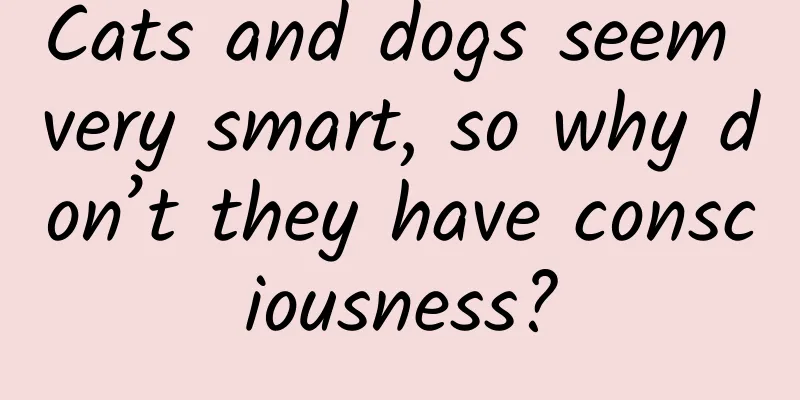Cats and dogs seem very smart, so why don’t they have consciousness?

|
In the posts about consciousness that I have published in the past, I often hear some netizens questioning how animals can be without consciousness. This is nonsense. My dog is the evidence. My dog is very well behaved. He is very close to his owner and remembers acquaintances after a long time. Isn't this ironclad evidence of consciousness? In order to explain why dogs have no consciousness, let's talk about it in more detail. These netizens are not wrong. In fact, dogs are generally very well behaved. But being well behaved does not mean being conscious. Being close to the owner or remembering the owner after a long time is not consciousness. These can only be collectively called animal instincts or conditioned reflexes. All animals, including bacteria, have instincts and the ability to make choices for survival. Otherwise, life would not be able to evolve, and there would not be a world with billions of species coexisting today. At the scientific and philosophical level, there is a strict distinction between consciousness and instinct. Consciousness is a general term for logical memory and logical thinking. It is the top crystallization of the evolution of species on Earth and a unique ability of humans. Textbooks define consciousness as: consciousness is the human brain's awareness of the internal and external appearances of the brain, and is the human brain's reflection of the objective world. Instinct is the ability of life that has evolved in order to adapt to survival. It is an ability that all life possesses, whether it is invisible bacteria, plants, or the largest animals. It is the most significant feature that distinguishes life from non-life. The biggest difference between consciousness and instinct is whether a creature has self-awareness and logical memory and thinking ability. Only humans have the combination of these two abilities. A very small number of other animals may have a little self-awareness, but logical memory and thinking abilities are impossible for them to exist because this ability, in addition to being obtained through genetic mutations, also requires basic tools to assist in realization. This tool is language and time labeling. Through continuous cognition of nature, human beings have mastered increasingly mature languages linked by concepts. From then on, they can use concepts and language to abstract memory and thinking and label them in chronological order. In this way, human beings can transform their cognition of the objective world into organized abstract thinking and memory, and record the accumulated knowledge and experience through writing, inherit and pass it down from generation to generation, forming the history of human civilization. Therefore, "consciousness" in the philosophical sense, or the modern special term "consciousness", refers to an ability unique to humans. It is a general term for human self-awareness, memory, and thinking. This consciousness is not possessed by any other animal, including dogs and cats. In fact, dogs and cats are not the smartest animals in the animal kingdom. It's just that humans domesticated them earlier, forming a closer attachment to humans. In the animal kingdom, some animals such as chimpanzees, elephants, and dolphins are smarter than dogs and cats because they have some shallow self-awareness. What is self-awareness? Self-awareness is the knowledge that one is oneself and can distinguish oneself from other people or animals. This cognition is very important and is the basis of consciousness. Without this self-awareness, there is no consciousness. Just imagine, if you don’t even know who you are and can’t distinguish yourself from other people, how can you have logical thinking and memory? Each of us has a unique sense of self, and we all think that we are unique individuals. This feeling is very strange. Think about it, is there an "I" in your mind that controls all your actions? Scientific research believes that this mutation in humans occurred in an ancestor between 8 million and 10 million years ago. The genetic mutation gave this ancestor self-awareness, and he awakened from then on and led his descendants to part ways with their common ancestor, the chimpanzee brothers, gradually walking out of the jungle and reproducing and developing towards the human lineage. There is no logic to this kind of gene selection. Just like the origin of life, it is entirely due to probability and chance. This kind of selection happened to humans. Since then, humans have stood out from other animals and become the masters of this world. The emergence of self-awareness allowed human ancestors to communicate more and more and understand more about nature, and gradually formed concepts. Concepts are the cells of language. They are the marks that humans use to rise from sensory cognition to rational cognition of objective things in social practice, abstracting the common essential characteristics of perceived things, summarizing them and storing them in the mind, such as sky, earth, people, animals, etc. These are basic symbols of thinking and memory. The gradually accumulated concepts allowed the ancient apes living in groups and later tribes to reach a consensus on certain things through communication, making the transmission of information more and more convenient and accurate. During communication, people used various adverbs to string concepts together, forming an increasingly rich language. With the perception and understanding of natural phenomena such as sunrise and sunset, day and night, ancient humans gradually developed the concept of time; in long-term labor, record-keeping, exchange and other activities, people began to understand quantity, and gradually developed numbers and counting. In this way, there are labels of time sequence and numbers in memory and thinking, making memory and thinking more and more rigorous and logical. As a result, concepts, time, and numbers have become basic tools for memory and thinking, allowing human self-awareness and memory thinking to undergo a qualitative change from sensibility to rationality, and become increasingly mature and profound. Humans also record their discoveries, inventions, and experiences through writing and pass them on to the next generation, allowing human civilization to continue and allowing the human brain to evolve and improve. This is the essence and cause of human consciousness. Dogs and other animals have neither evolved self-awareness nor the basis for consciousness; nor have they formed racial consensus on concepts, time, and numerical cognition. Without these tools to strengthen memory and thinking, overall consciousness would certainly not be generated. In order to verify whether other animals have self-awareness, scientists have thought of many ways, including studying the brain and behavior of animals, but there has been no rigorous method. The most recognized method at present is the mirror test invented by American evolutionary biologist Gordon Gallup. The so-called mirror test is to let animals look in the mirror to see if they can recognize themselves in the mirror. The method is to make a mark on the animal's body without the animal's awareness, which cannot be seen or felt without looking in the mirror, but can only be observed in the mirror. When the animal looks in the mirror and knows that the image in the mirror is itself, it will find the mark on its body based on the image. Tests show that babies only begin to develop self-awareness at around 18 months old, so it is believed that human self-awareness is awakened at around 18 months old, and it is with the accumulation of conceptual language and the cognition of time that self-awareness awakens, eventually forming logical memory and thinking. Generally speaking, people will not remember things before the age of 3, because at that time, the tools for memory and thinking have not been mastered, making it difficult to form abstract memory and thinking. Most animals, such as dogs and cats, failed the test and were therefore judged to have no self-awareness. The ones that did pass the test included great apes (pygmy chimpanzees, chimpanzees, orangutans, humans, gorillas), macaques, bottlenose dolphins, killer whales, elephants, and European magpies. Therefore, these animals that passed the test are considered to have a certain degree of self-awareness. But why did these animals not develop wisdom and civilization? It is because they do not have the tools to form memory and thinking, that is, language and time digital labels connected by concepts, so they cannot abstract things, nor can they perform logical thinking and logical memory, and their self-awareness cannot be deepened. In the long-term communication, regardless of the type of writing or language, humans have reached a consensus on the cognition of all things in the world, such as people, chickens, ducks, cats, dogs, mountains and rivers, tables and chairs, trains, cars, airplanes, sky, earth and ocean, wind, rain, thunder and lightning, etc., plus time labels such as day and night, date, hours, minutes and seconds, etc., they can connect the various things that have happened, mark them, and abstractly portray them in the brain's memory storage area. When recalling, just find these labels and concepts to reproduce the scenes of the past. For example, on a certain day of a certain month of a certain year, I took a plane to Hainan with someone, or on a certain day and time, I visited the ends of the earth. These specific experiences will be abstracted and stored in the brain using concepts, language, and time labels to form memories. The same is true for logical thinking. Concepts and time labels must be used to carry out, whether it is Chinese, English, or French. If you don't believe it, try thinking about it without using concepts, language, and time labels. Can you do it? The animals that passed the mirror test did not form a concept or language for the group to reach a consensus, nor did they have strict time labels, so they could not form logical thinking and memory, let alone wisdom and civilization. Of course, it is not that there is no communication between animals. The so-called bird language and animal calls are the way animals communicate. But these communications are very simple, and can only convey simple signals such as danger, food, and finding a mate between the same group. Due to the lack of the concept of reaching a consensus, it is difficult to convey complex information. Since animals that pass the mirror test cannot develop consciousness close to that of humans, it is even more impossible for dogs and cats that fail to pass the test to have consciousness. But many animals can remember acquaintances and the path home, and even remember it for many years. Why is this so? In fact, the memory of dogs is mainly instinct and conditioned reflex. The famous Soviet physiologist Pavlov conducted many experiments and discovered the mechanism of animal conditioned reflex. The most famous experiment is the dog's saliva experiment. Dogs will secrete saliva when they see food but before they eat. So every time before the food appears in front of the dog, he regularly makes a certain sound, such as ringing a bell, blowing a whistle, using a metronome, etc. After a period of repeated training, he found that even if there is no food, as long as these sounds appear, the dog will drool. Before repeated training, these sounds will not stimulate the dog to salivate. This is the conditioned reflex, which is that almost all animals will react to special environmental stimulation and command the body to produce a certain function. Therefore, the dog's memory is mainly instinctive reaction and conditioned reflex, which is fragmentary and incomplete. A dog's eyesight is weaker than that of a human, but its sense of smell and hearing are much stronger than those of a human. Especially its sense of smell, which is 1,200 times stronger than that of a human. It can distinguish 2 million odors and can sniff out even very small amounts of them. Therefore, well-trained police dogs play an irreplaceable role in solving various cases. The dog's memory is mainly formed by olfactory memory, auditory memory, and of course visual and tactile memory. When dogs are exposed to various smells, sounds, images, and touches in different environments, they will be stored in the brain. However, since abstract thinking has not been formed, these memories can only be fragmented and short-lived, and they will be forgotten quickly. However, after long-term and repeated training, the dog's memory can be strengthened. Even if the memory has been strengthened, the dog will not do the same action or habit in different environments. This is because they do not have self-awareness and abstract thinking. The dog's long-term memory of the owner is because they have been with the owner for a long time, and the owner's smell, sound, image, and touch have left a deep impression in the brain, not a real logical memory. Consciousness in the philosophical and scientific sense belongs only to humans. Animals are not conscious, or do not have consciousness in the scientifically defined sense. This is only the definition of science and philosophy at this stage. Research on consciousness has only scratched the surface. Studies on animal self-consciousness, such as the mirror test, are also controversial and not conclusive. Perhaps there will be subversive discoveries in the future. Let's wait and see. This is an original article from Space-Time Communication. Please respect the author’s copyright. Thank you for your reading, understanding and support. |
>>: Was the third flight of SpaceX Starship a success or a failure?
Recommend
The first red alert! Nanning suffered heavy rain and many places in the city were flooded. How to prevent it scientifically?
Summer rain comes as soon as it is expected. On t...
Jaguar creates AI concept steering wheel: can communicate with people and perform tasks
According to foreign media reports, Jaguar recent...
A must-read for marketers: 5 senses and abilities you must master!
I have read many marketing books and found that th...
How to play brand marketing, the 4 core basic skills you must master
What is Marketing ? Marketing is a means of satis...
A large amount of Qianchuan running material "production formula" [with script plan]
As the saying goes: An optimizer who doesn’t unde...
618 Marketing Promotion Plan Creation Guide, 1 Step to Get It Done
Every marketing plan with soul must not be a pile...
Although air conditioning can "extend life", if this step is missing, it is really easy to get sick!
The summer is hot and humid. After being outdoors...
JD.com’s 6.18 event has lasted for a month. What operational weapons does it have?
When you think of June 18, 2017, what’s the first...
Taking Pinduoduo as an example, we will analyze the paid membership tier model and operation ideas
This article takes the mainstream payment system ...
Wang Ju, Travel Frog and other hot spots review skills, 3 tricks to teach you how to create hot spots
Recently, a colleague asked me how to analyze soc...
Can Apple Watch use the same charger as iPad?
It has been more than three months since Apple of...
Cocos Studio V2.1 Open Plan Announced
On December 19, Cocos Studio, a product of the Co...
Automobile maintenance information collection of high-quality resources Baidu network disk download
Automobile maintenance information collection of ...
User Operations: 3 Secrets of Super User Thinking!
The story of the internet celebrity boss lady: As...
Are the skin care concepts you know about "beauty secrets" or "face-ruining methods"?
Last month, I received an email from my fan frien...









